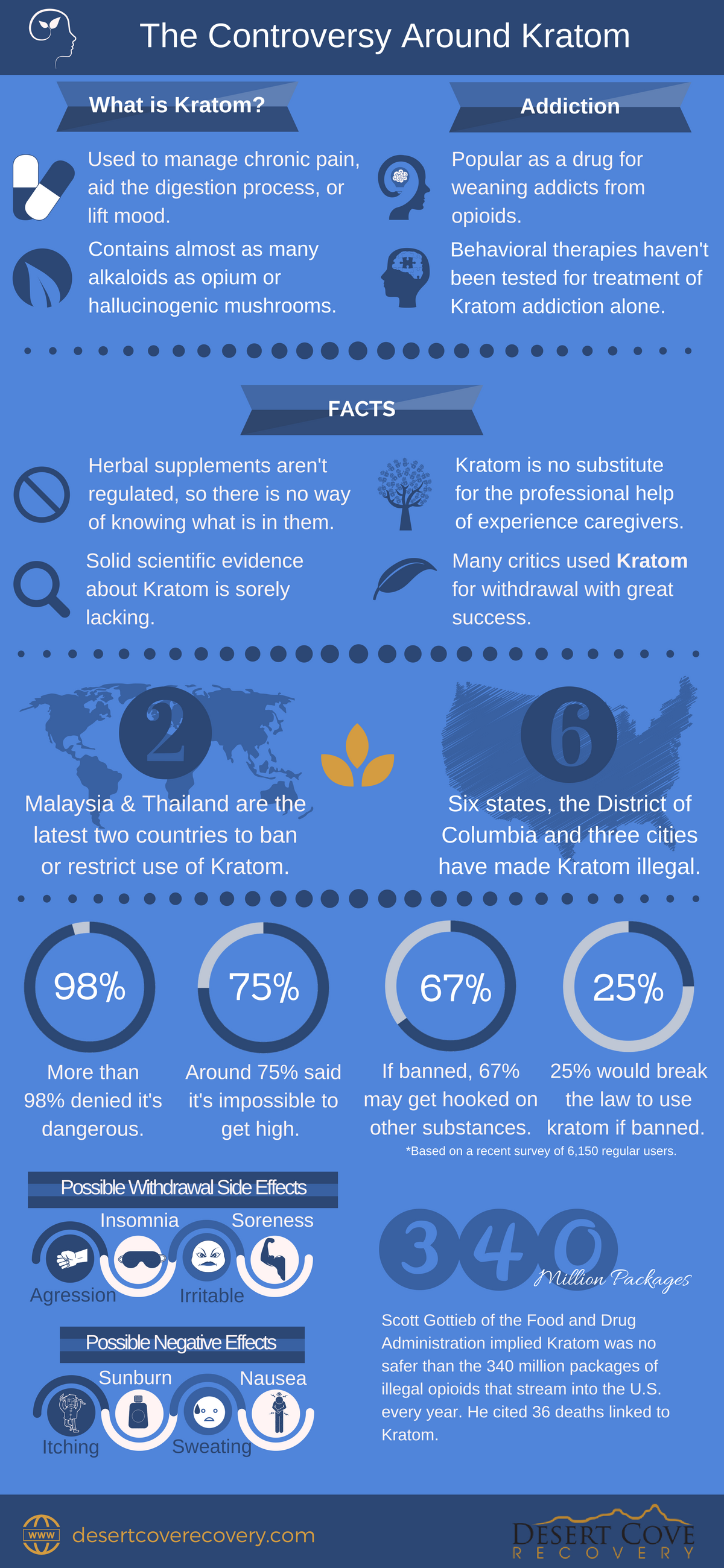Kratom for opioid withdrawal: Does it work?
In the war on drugs, there’s a war on a plant-based herbal supplement called kratom. Advocates swear by it as a pain reliever, a mild stimulant or an aid in beating opioid addiction. Many proponents say that they’ve used kratom dosage for opiate withdrawal with great success.
Detractors point to its mind-altering and addictive properties. Federal authorities have attempted to classify kratom, which is legal and widely available, as a Schedule I drug in the same class as heroin and LSD. Schedule I drugs are considered dangerous for their high potential for abuse and lack of known medical benefits.
Everyone agrees that solid scientific evidence about kratom is sorely lacking.
Continued after image…
What Is Kratom?
Kratom is derived from an evergreen plant in the coffee family. It is native to South Asia, but Malaysia and Thailand are now two of the 16 countries that tightly control the use of kratom or ban it altogether.
In the U.S., kratom leaves are typically ground into a powder and brewed as a tea. In doses of a few grams, kratom acts as a mild stimulant for alertness and sociability. At doses of 10 to 25 grams, it acts as a sedative. The user may feel calm and euphoric.
Kratom is mostly used to manage chronic pain, aid digestion or lift mood, but its popularity as a drug for weaning addicts from opioids has generated a storm of controversy.
What’s All the Fuss About Kratom for Withdrawal??
Kratom isn’t an opioid, but it contains almost as many alkaloids as opium or hallucinogenic mushrooms. The U.S. government gets alarmed, understandably, when kratom powder is touted as a safe, legal, cheap high. Herbal supplements aren’t regulated, so there’s no way of knowing what’s actually in them.
According to a study conducted at the Centers for Disease Control and Prevention, kratom-related calls to regional U.S. poison control centers increased tenfold between 2010 and 2016. The CDC warns of an emerging health threat, especially when kratom is combined with alcohol or other drugs.
In a recent statement, Scott Gottlieb of the Food and Drug Administration implied that kratom was no safer than the 340 million packages of illegal opioids that stream into the U.S. every year. Gottlieb also cited 36 deaths linked to kratom.
One of the raw kratom’s chief alkaloids is mitragynine, which is thought to activate natural opioid receptors without depressing the respiratory system. That’s why so many proponents of kratom are excited about its potential as a safer pain medication. Between 1999 and 2016, more than 200,000 Americans died from a prescription opioid overdose.
A woman named Susan Ash recovered from Lyme disease only to wind up addicted to pain pills. After detox and addiction treatment, she stumbled across kratom and has used it every day since. Indeed, she attributes her recovery to it. Ash and thousands of other users regularly lobby against state bills that would ban the sale of kratom. Six states have made kratom illegal.
Others aren’t so sure about kratom for withdrawal and insist that Ash and other recovering addicts are anything but clean.
Dariya Pankova was battling a heroin addiction when she tried kratom. She became hooked on it and eventually returned to the more potent heroin. A South Florida man who was trying to quit opiates through kratom had a similar experience. He developed tolerance to kratom and returned to rehab many times before he beat his addiction to it.
Respondents to a recent survey of 6,150 regular users told a different story:
- More than 98 percent denied that kratom is dangerous.
- Around 75 percent said that it’s impossible to get high on kratom.
- Almost 67 percent considered themselves more likely to get hooked or overdose on other substances if kratom is banned.
- Almost a fourth said they would break the law to use kratom after a ban.
According to the National Institute on Drug Abuse, kratom’s negative effects may include the following:
- Sensitivity to sunburn
- Nausea
- Itching
- Sweating
- Dry mouth
- Constipation
- Increased urination
- Loss of appetite
- Psychotic symptoms
Researchers at NIDA believe that kratom is habit-forming. Reported side effects during withdrawal include the following:
- Muscle aches
- Insomnia
- Irritability
- Hostility
- Aggression
- Mood swings
- Runny nose
- Jerky movements
It’s important to note that behavioral therapies have not been tested for treatment of kratom addiction alone.
Is Kratom Right for You?
It’s hard to make a good decision about kratom until far more research is done. Many recovering addicts see it as a godsend during opioid withdrawal, but many others flatly insist that using kratom is the equivalent of relapsing.
One thing’s for sure: Where opioid addiction is concerned, kratom is no substitute for the professional help of experienced caregivers.
Call Desert Cove Recovery today. We’re committed to helping you heal and reclaim your life.




